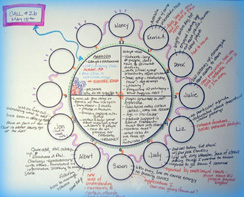 TELECONFERENCE CLOCK METHOD TELECONFERENCE CLOCK METHOD |
| Method designed to assist moderators to regulate and facilitate the interaction between participants during conference calls.
The Teleconference Clock creates a speaking sequence for introducing each participant: people are given a place on the clock as a mechanism to ensure that everyone has a chance to speak. The “clock” is used to encourage participation on conference calls or structured online chats involving more than four people. [1] |
 Conducting a Teleconference Clock Conducting a Teleconference Clock |
Preparing a Teleconference Clock
- Have an agenda that includes conference goals and participants’ expectations.
- Think about the time zones of participants when scheduling.
- Consider the impact of comments volume (based on the number of participants) with the available time.
- Send all participants the dial-in number and pass-codes if needed. With international groups, be clear if the number is cost-free.
- Distribute supporting documents or files before the beginning of the conference call.
- Take care in advance of the call controls. If the leader controls the start/stop of the call and may have to leave early, have a second person with leader privileges in order to avoid call interruptions.
- Greet everyone once online and use the “clock" method for the introduction of each participant.
Step by Step
 The template for this technique is from Ray Guyot [2] The template for this technique is from Ray Guyot [2]
- Ask every participant to get a piece of paper to draw a circle on it and mark the hours like a clock.
- Assign each person a spot on the “clock” when joining the conference call. The first person on the call put his name on 1 o’clock hour, the second 2, etc. If there are more than twelve people, start adding 1:30, 2:30 etc.
- Use the “clock order” to create a speaking sequence which ensures the participation of everyone. Participants can make notations and use the piece of paper as a visual tool to match names, voices and inputs.
- Vary the position of the participants on the clock if you are planning multiple rounds of speaking.
- Use feedbacks or evaluations to improve possible later calls. An "after action review" can be done at the conclusion of the call or by post-call emails.
- Ask each participant to describe with three adjectives their “clock” experience.
General Call Etiquette
- Call from a quiet location.
- Avoid cell phones and speakerphones. If you use them remember to put the mute button when not talking.
- Use quality headsets to avoid metallic sounds.
- Avoid paper rustling.
- Caution with multitasking; some is unavoidable but remind people about attention: occasionally call for a moment of silence to keep their attention.
- Consider a kind treatment of participants’ bodies: on long calls, offer short breaks.
- Speak clearly and slow down if you are a "fast talker".
- Be enthusiastic and use a tone appropriate to the group (the first impression is important).
- Vary voice tone (avoid monotone presentations).
|
Job Aid
 Using Teleconference Clock
Using Teleconference Clock
References
- ↑ www.fullcirc.com (26 November 2009),www.ilo.org (26 November 2009), www.kstoolkit.org (26 November 2009)
- ↑ www.fullcirc.com/wp/2008/03/14/using-the-clock-on-telecons (26 November 2009)
